Japan Paper Tour Recap
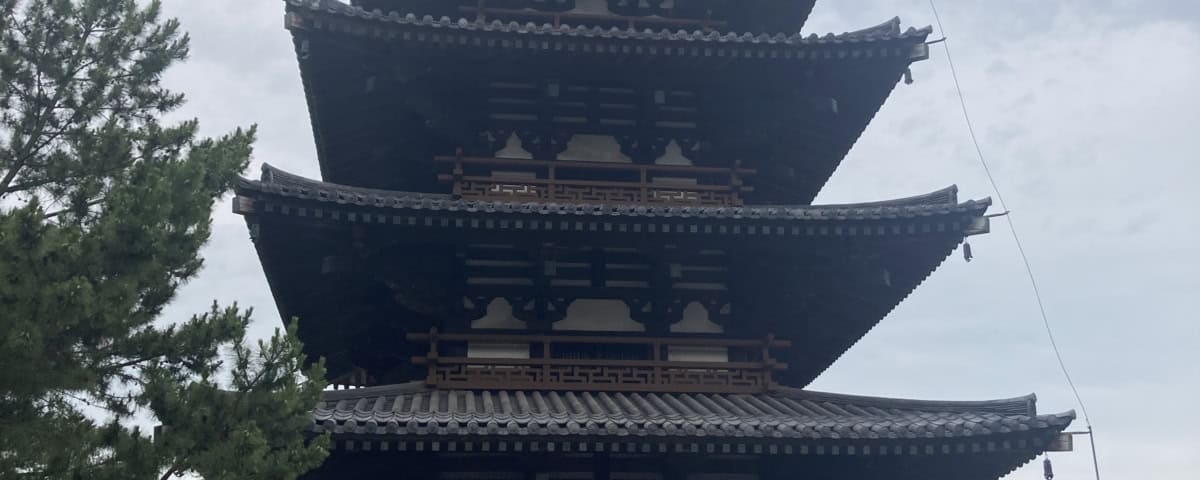
The Sunday Paper #513
I’m back from Japan, and next week, we’ll return to the regular Sunday Paper. This week is all about my recent paper-related trip.
But first, I want to remind you that The Paper Year is open to new members through July 10th. We explore a different technique and project every month, and the third quarter launches tomorrow with Paper Inflatables, like the pink one below that I saw at Ozu Washi in Tokyo (what a coincidence)! Read more and sign up to join The Paper Year.
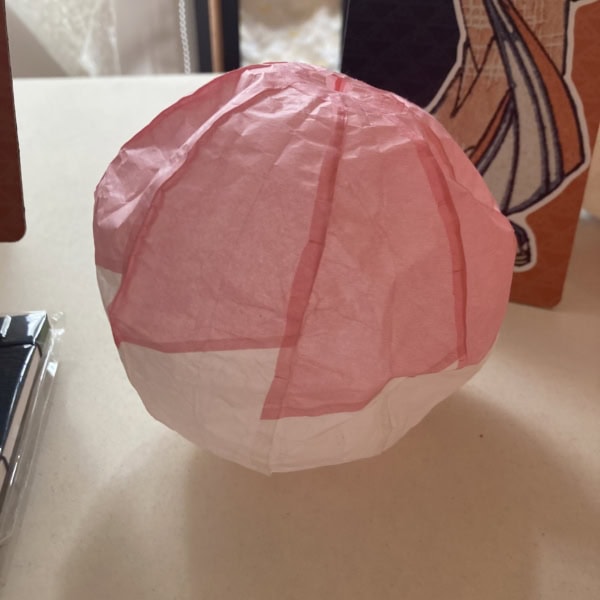 |
 |
Now, Japan!!!
The Japan Paper Tour was an 11-day trip in June of 2024. The seed was planted when I traveled there with my husband in late 2019. I blogged about that trip here – Part 1, Part 2, Part 3 – and started collecting names of those who might be interested in traveling with me in the future. The pandemic set in shortly afterwards, but the trip finally came to life five years later.
Pre-Tour
I flew to Japan a week before the tour began to acclimate and get over jet lag. Two participants joined me for a couple of days in Tokyo followed by a brief trip to two of the Art Islands (Teshima and Naoshima). In Tokyo, we went to paper shops: Itoya (like a paper Disneyland, filled with eye candy + crowds); Paper Nao (hand painted papers – 1000’s of them!); and Ozu Washi (a lovely shop with a museum and demonstration area). We also stumbled across the Fukui Antenna Shop, featuring craft products (including paper) from Fukui prefecture, where we were headed first on the tour. We caught up with Paul Denhoed at dinner one evening, who is associated with Oguni Mill in Northern Japan. I know Paul from my time in NYC when I worked at Dieu Donné and he worked at Kate’s Paperie.
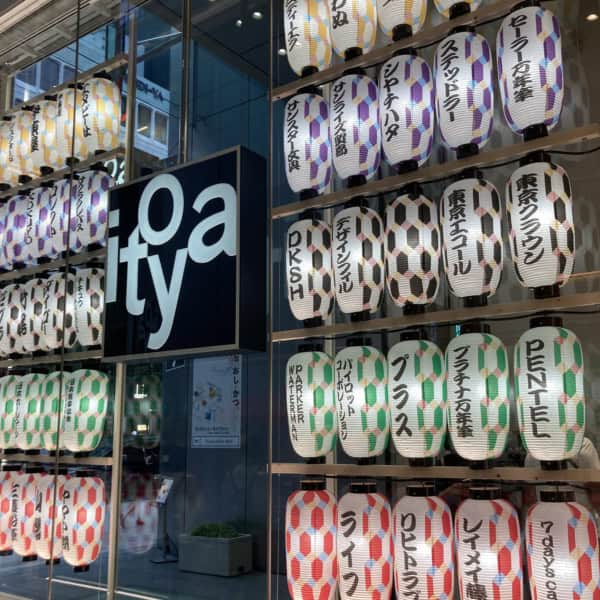 |
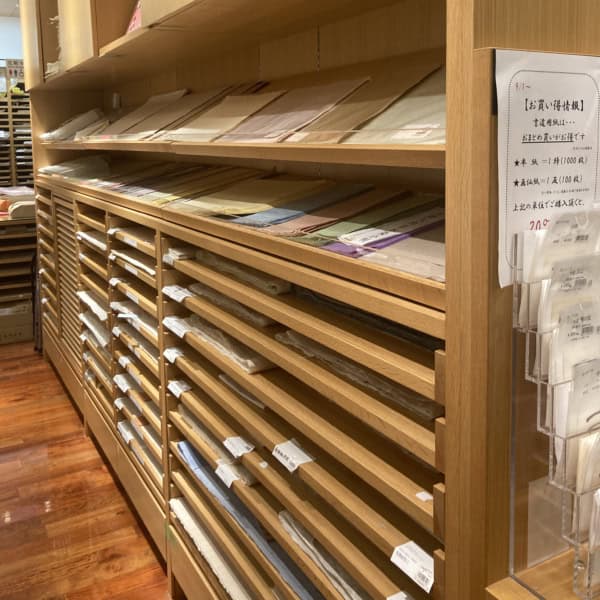 |
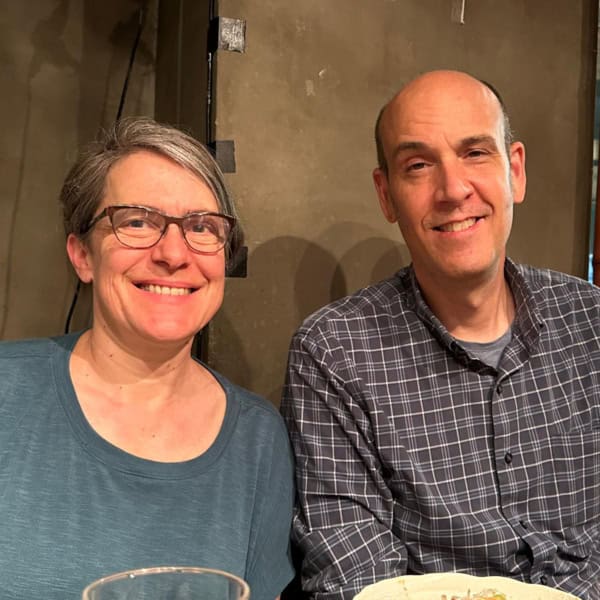 |
Day 1: Train to Takefu
Our group converged at Kansai Airport’s Hotel Nikko, where we had dinner together and spent our first night. Our trip planner (and Kyoto guide later in the trip), Masa Fujiwara, greeted us and sent us on our way to our first stop, Echizen Paper Village.
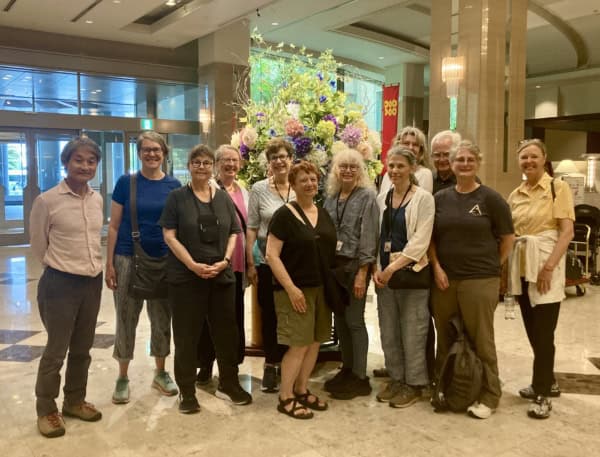
L to R: Masa Fujiwara (JP), Helen Hiebert (CO), Linda Armstrong (GA), Diane Tomasso (CO), Helen Spielman (NC), Karen Jones (CO), Jill Powers (CO), Gina Pisello (WA), Kathy Bayard (NC), Eric Avery (TX), Michelle Scarlett (ME), Susan Mackin Dolan (CO).
We took the train to the brand new Takefu Station, a few miles from the paper village, and then walked through the rice fields to a business hotel, the Route Inn Takefu – note the street sign to the Japanese Paper Village. June is hot and steamy in Japan, and shopping (mostly for paper) was a big part of the tour. At this stop, we enjoyed fruit popsicles after arriving at the station.
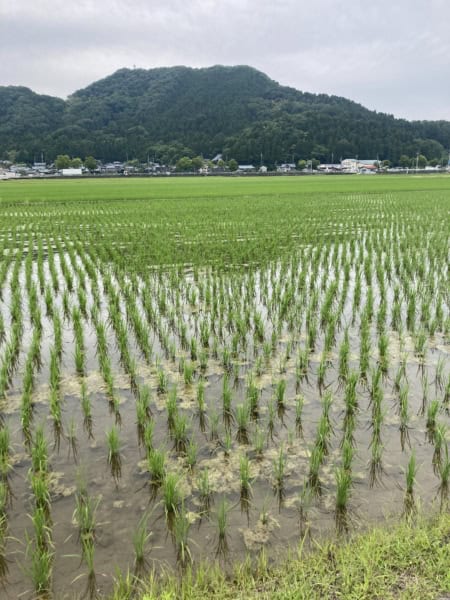 |
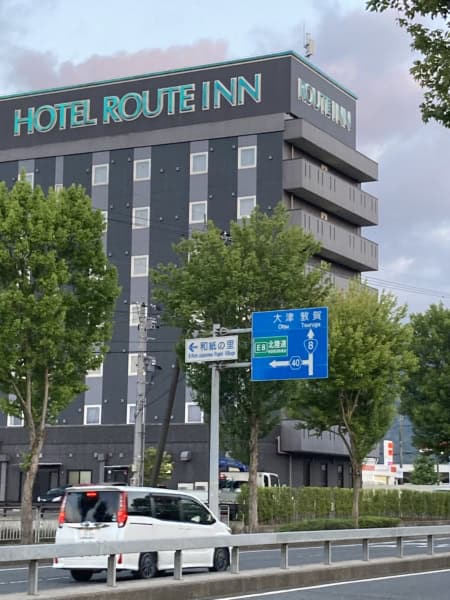 |
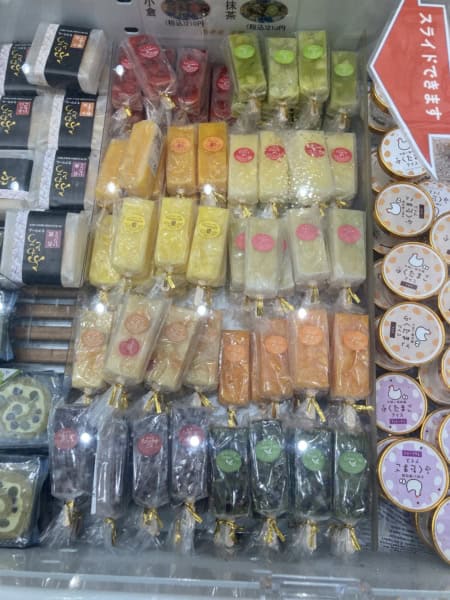 |
Day 2: Mill Visits + Paper Shrine
The tour’s inception came from my previous trip to Japan when I met Nick Cladis, who teaches papermaking at the University of Iowa Center for the Book. Nick lived in Echizen for 6 years and spent a day giving my husband and me a delightful tour of several mills, followed by a potluck dinner with members of the papermaking community there.
We took taxis into the paper village each day, where we met up with Nick, who was our guide and translator. We spent an hour each at three different mills. I could write a full blog post about each visit, but to keep this brief, I’ll share one tidbit from each. At Igarashi Mill, we saw the three main plants used in papermaking (kozo, mitsumata and gampi) and learned about a scientist who is trying to cultivate gampi, which is very difficult to do; at Yamaguchi Mill, we met the husband and wife team (and their apprentice) who create gorgeous single and double-layer sheets that are all board dried; and at Taki Mill, we all got to try spraying into the pulp on a huge sheet of paper.
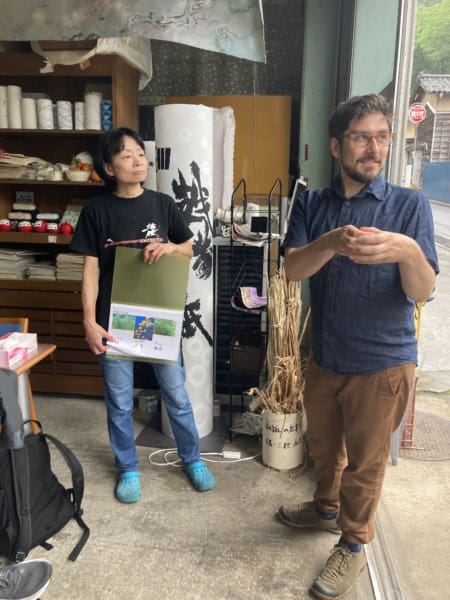 |
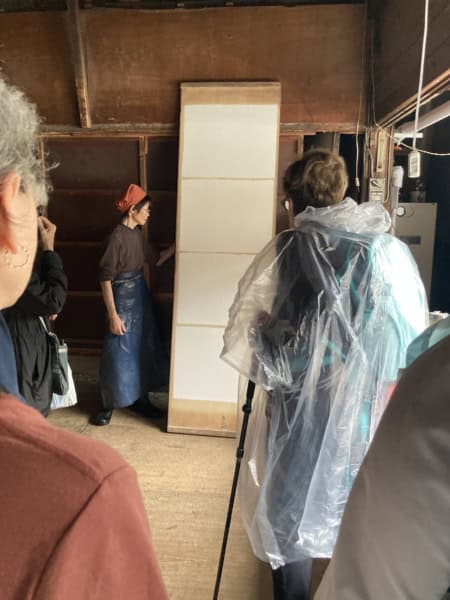 |
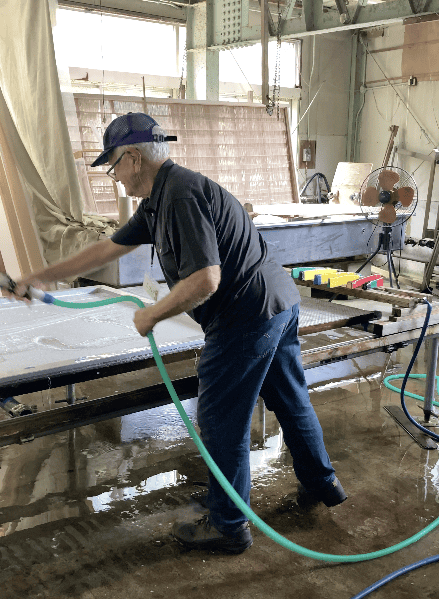 |
That afternoon we visited the Okamoto Otaki Shrine, the only shrine in Japan to be dedicated to Kawakami Gozen, the goddess of paper.
Day 3: More Mills + A Paper Distributor
We began our day at the shrine again (a good taxi drop-off location) and walked to Yanase Mill, where we gaped at two young papermakers working in tandem to create huge sheet after sheet. Mrs. Yanase showed us how she makes hikkake paper, an unusual stenciling technique. Next, we visited Osada Mill, where the proprietor shared several of his techniques with us. Many of these mills create large sheets for fusuma door panels and other interiors, such as lighting and wallpaper. Our third mill that day was Ryozo, where they make paper by hand, and then utilize a conveyor belt system – that they couch the sheets onto – to press and dry the sheets. They also create two different kinds of lace papers, and we were treated to a demonstration.
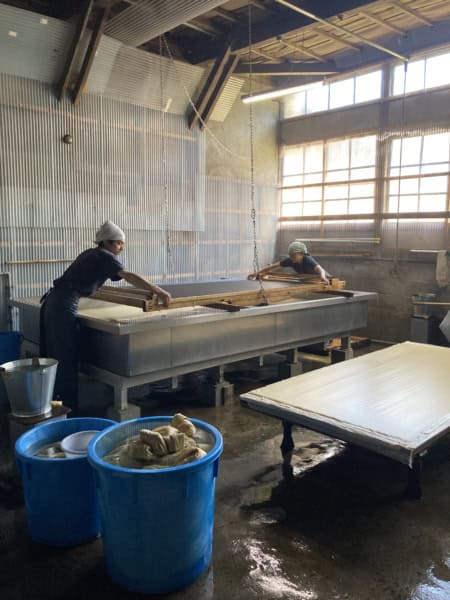 |
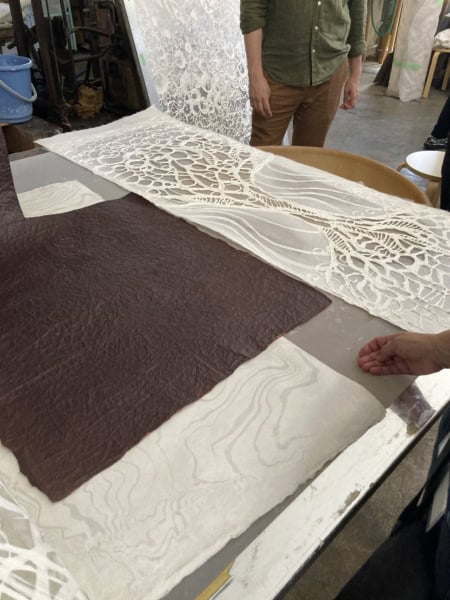 |
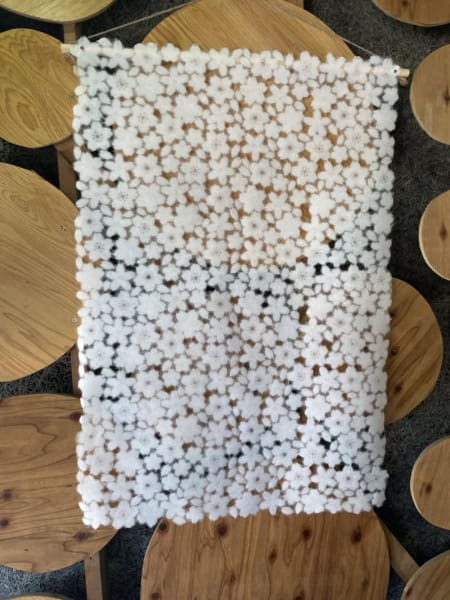 |
That afternoon we visited paper distributor, Sugihara Shoten, who has a beautiful showroom where we saw more papers from numerous mills around Echizen, as well as products created with the papers and special projects that have been facilitated with companies like Fendi.
Day 4: Udatsu Paper & Craft Museum and Paper Shops
We divided into two groups and split our time between learning how to make Japanese paper at the Udatsu Paper & Craft Museum and visiting several paper shops in the village. Each participant got to try their hand at making 2 large sheets of paper, which definitely takes some getting used to – my sheets were nothing to write home about, but I truly enjoyed the experience.
 |
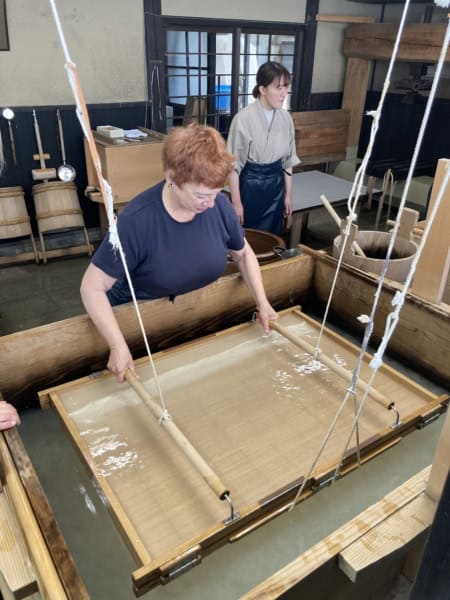 |
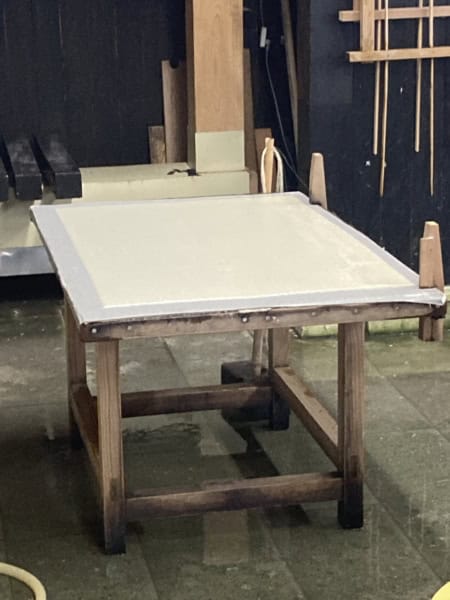 |
Day 5: Travel to Gifu, then Mino: Lanterns + Umbrellas
I met Andrew Dewar about 3 years ago, when he joined my Facebook group, The Paper Studio. He participates in our “flaunt it Fridays” almost every week, but more importantly he is an expert paper folder, specializing in paper objects that fly. When I learned that he lived in Gifu, near Mino, I asked him whether he would like to guide us for a couple of days. I knew that Isamu Noguchi had been in the area in the 1950’s to help modernize their collapsible lanterns (if you can’t make it to Japan, you can visit Noguchi’s old studio just outside of NYC). Andrew took us to Ozeki & Co., where Noguchi’s Akari Lights are still available, along with the traditional Gifu designs. Then we went to Kawara-Machi and visited Gifu Wagasa, a delightful shop that sells paper umbrellas. We were able to step into the workshop and meet a young craftsman who prepares the bamboo parts for the umbrellas.
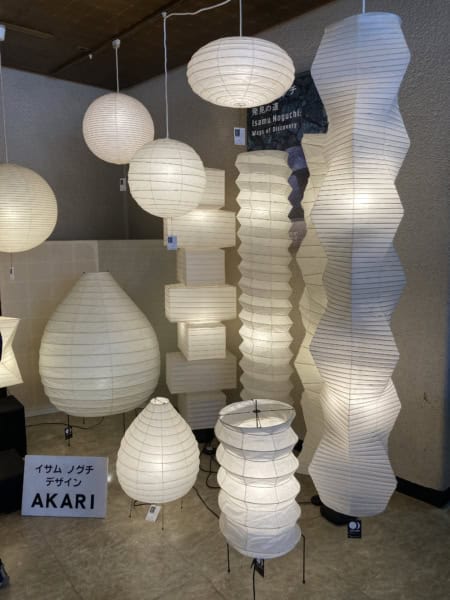 |
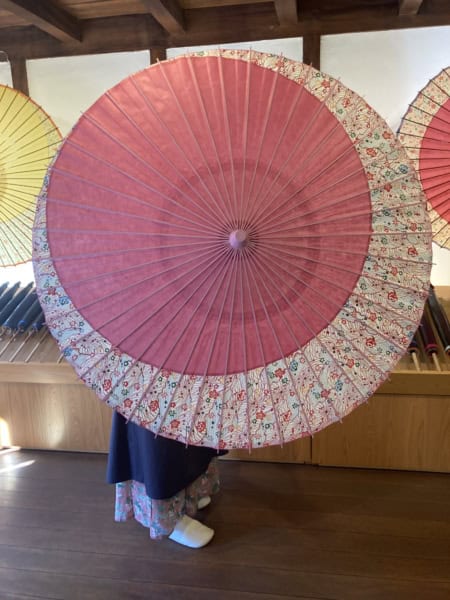 |
 |
After touring in Gifu, we had a lovely meal on the river – I think we counted 10 courses – and then took the public bus to Mino.
Day 6: Paper + Light
As luck would have it, a paper colleague who had been in Mino introduced me to Akiko Furuta, who lives in town and is a volunteer tour guide. After a brief tour of everyone’s room in the traditional Japanese ryokan (Nipponia Mino Merchant Town Hotel), filled with traditional shoji screens, gorgeous woodwork, fusuma paper doors, and gardens, views), Akiko generously handed out brochures and took us to a few sites, pointing out others for us to return to on our own later in the day. Mino has several paper and lantern shops, and Hideka Kano gave a lively miniature chochin (collapsible lantern) demonstration. Mino has an annual paper lantern competition, and the Mino Washi Akari Art Gallery is filled with innovative designs. The afternoon was topped off with an origami lesson with Andrew, who taught us how to make three different designs, two which flew.
 |
 |
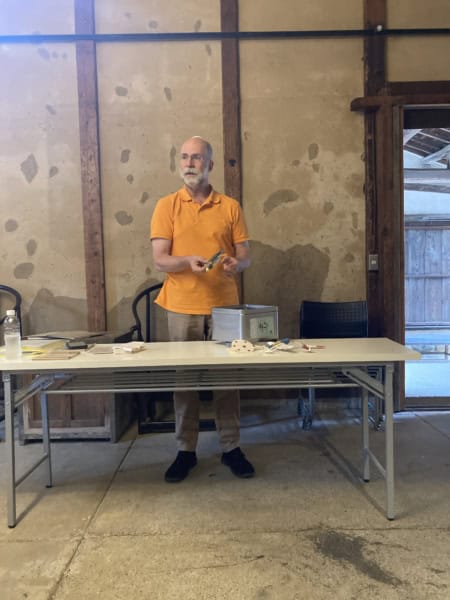 |
Day 7: Travel to Kyoto
We re-connected with Masa in Kyoto, who planned a three-day itinerary of historic sites in the mornings, leaving our afternoons free to visit paper shops and artists. Masa is married to Sarah Brayer, an American paper artist who has been in Japan for 40 years and was my connection to Masa (I met Sarah when she came to make work at Dieu Donné in NYC in the mid-1990’s).
We had time for a few activities between our train ride to Kyoto and checking in at the Celestine Hotel Gion (Masa chose excellent hotels and planned our train travel). Our first stop was in the upper food court at the Kyoto train station, where Eriko Horiki, a paper artist who has done installation and lighting work all over Japan, did a recent ceiling installation piece. Next we visited Sanjusangen-do, a Buddhist temple with a great hall that houses 1001 life-sized, wooden statues of Kannon, the goddess of mercy (carved in Japanese cypress covered in gold leaf). Next, we visited Kawai Kanjiro’s house, tucking into a small doorway that opened up into a beautiful home designed by the ceramic artist in the 1930’s, complete with a huge kiln out back.
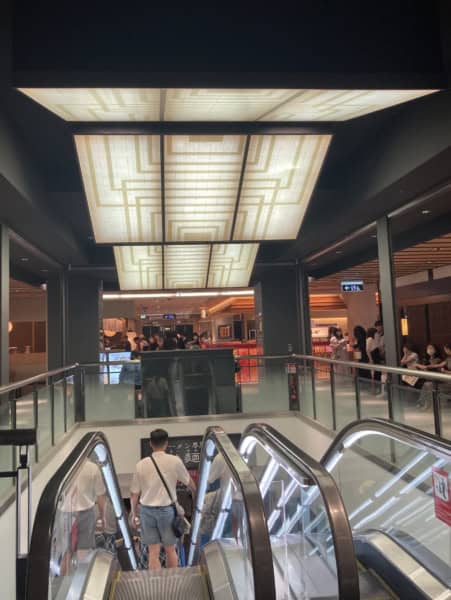 |
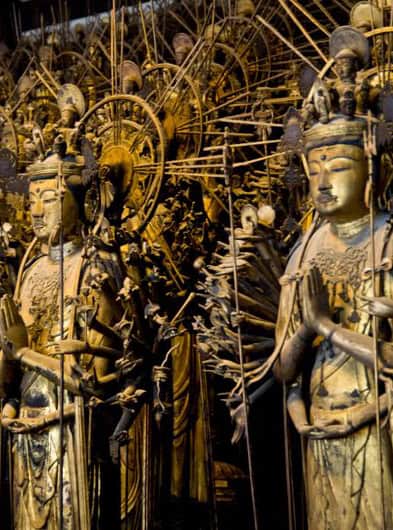 |
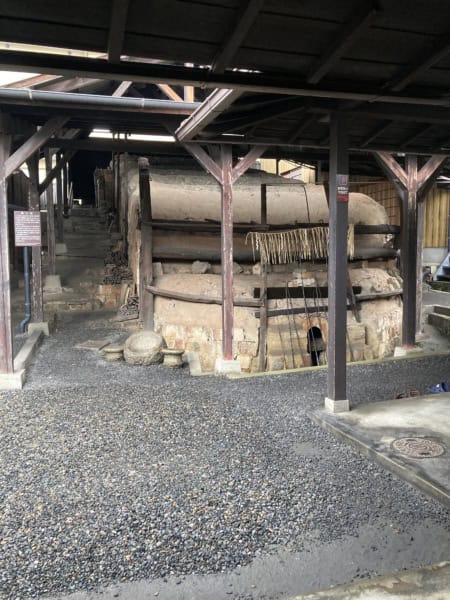 |
Day 8: Kyoto Zen Tour
I think it would be cool to be a tour guide like Masa, who has a chance to visit these special sites during different seasons. I can only imagine Ryoan-ji in the spring (with flowers) or fall (with colorful leaves). The rock garden was stunning and contemplative in summer too. I learned that the main rocks in Japanese rock gardens have at least half of their “body” buried underground. We headed to Kinkakuji, the Golden Pavilion next, a Zen temple whose top two floors are completely covered in gold leaf. Masa knows the abbot at Zuiho-in, located in a vast complex of Daitoku-ji which hosts a large number of Zen temples. The abbot served us tea and answered our questions about the temple and his life there. After a delicious lunch on the temple grounds, several of us wandered through the streets of Kyoto to a fabric shop, an indigo shop, Aizenkobo (where we got to see the vats of indigo) and Morita Washi.
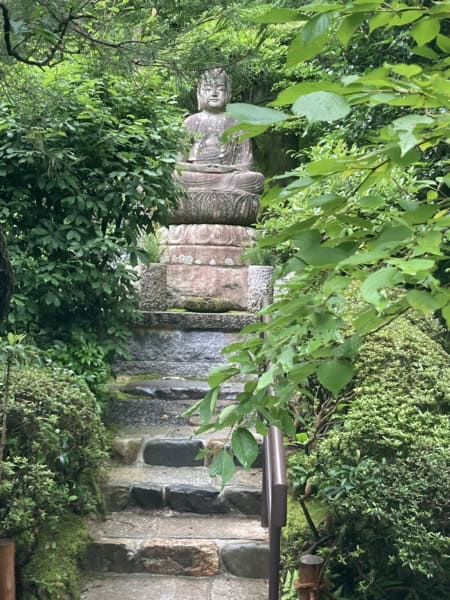 |
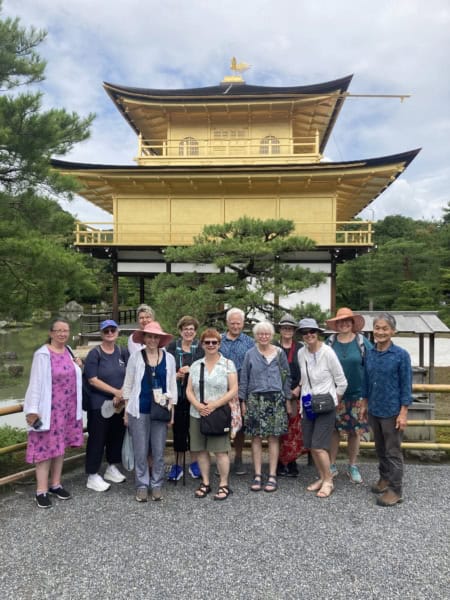 |
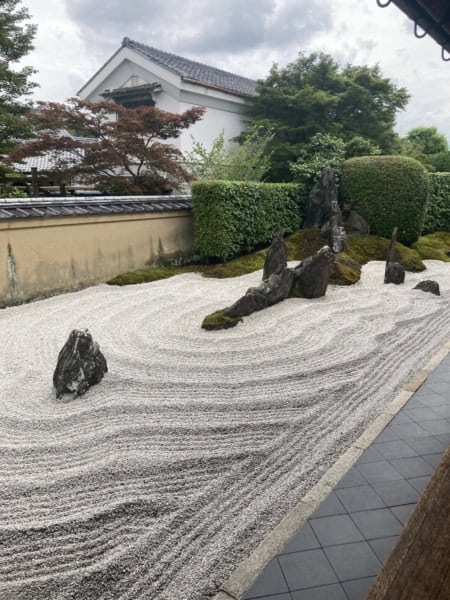 |
Day 9: Day Trip to Nara
We took two vans to Nara, the former capital of Japan and a Unesco World Heritage city. Our first stop was at Todai-ji, which features the Great Buddha Hall housing the world’s largest bronze statue of the Buddha Vairocana. We walked through Nara Park to Kasuga Taisha Shrine. I actually got lost with a couple of tour members and missed seeing this site (with numerous stone lanterns, darn!) but this sentiment makes up for it:
“Just like in ancient times, services are offered every morning and evening, and still today, prayers are offered for national and global peace, and for the happiness and wellbeing of all people”.
After lunch at the Nara Hotel – of architectural interest and built for visiting dignitaries in 1909 (Helen Keller and Albert Einstein among them) – we visited Horyuji temple, which houses the world’s oldest surviving wooden structures.
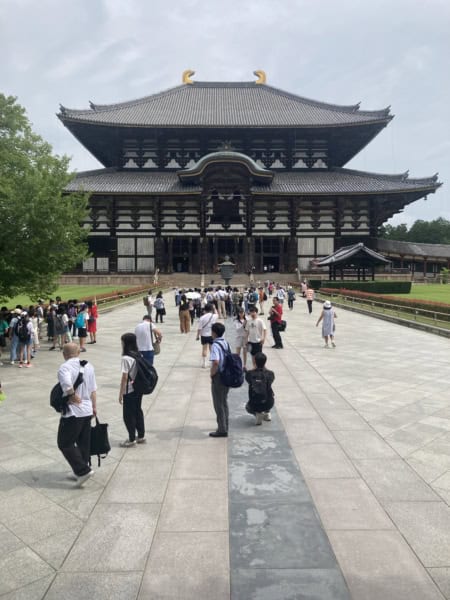 |
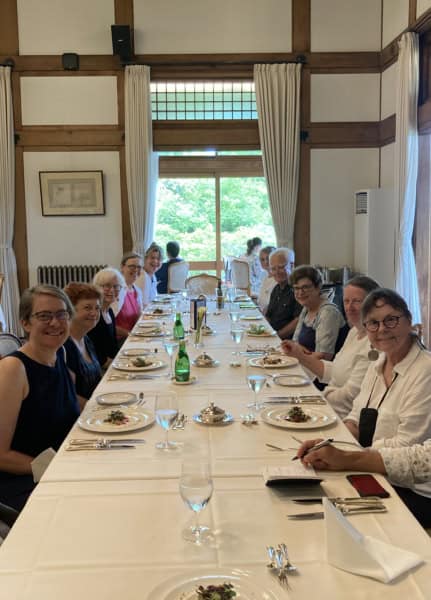 |
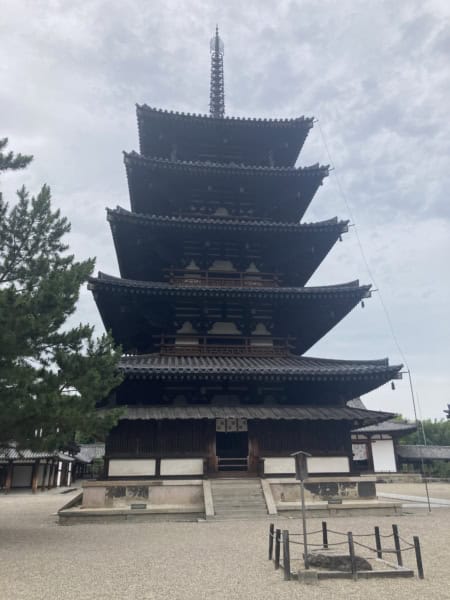 |
Day 10: Arashiyama Tour
When we were in Kyoto in 2019, my husband and I rode our bikes from our airbnb to Arashiyama, a stunning bamboo grove. This time, we traveled by train and walked across the river into the lovely neighborhood that is adjacent to the forest, meandering through a few gardens on the way, where we saw a lotus flowers in full bloom. That afternoon, we visited the Chushin Art Museum, where the artist Kyoko Ibe met us and talked about her work in handmade paper. What a treat to hear her speak about the work. Several of us visited Rakushikan Paper Shop afterwards.
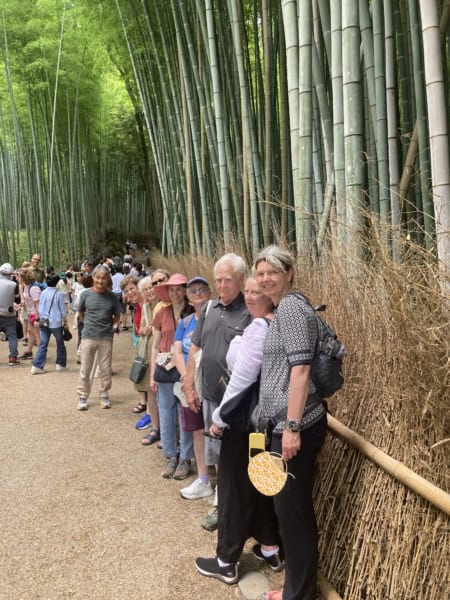 |
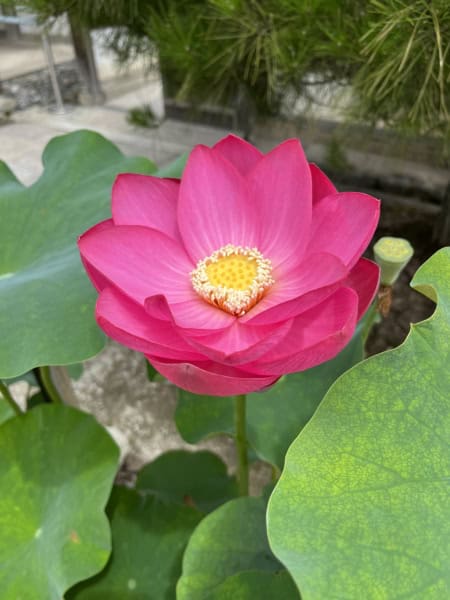 |
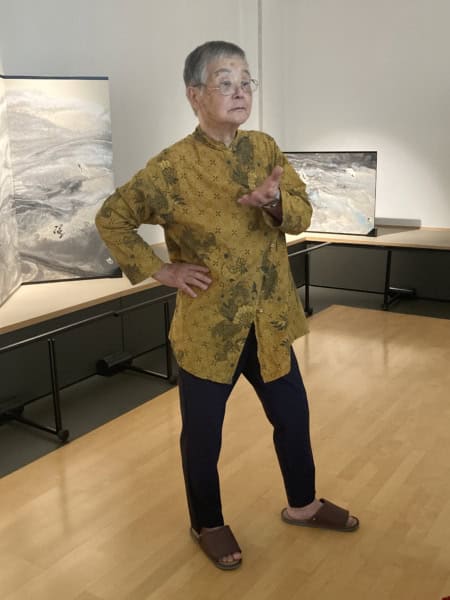 |
Day 11: Printmaking
Most of the group visited Karamaru on our last morning in Kyoto, a traditional printmaking shop that I’d stumbled across in 2019. They practice the karakami style of woodblock printing, which involves placing a sheet of paper on top of the block (they have a collection of 300-year-old woodblocks) and hand rubbing each print. We participated in their printing experience (we watched a short video, followed by a demonstration, and then each us us got to print 3 sheets). At the end of our session, the master printer showed us how he prints fusuma door panels, which requires 24 passes and a lot of moving the paper around with perfect registration. Several of us visited Kamiji Kakimoto afterwards, another wonderful paper shop that was within walking distance (the shelf in the photo houses papers made by hand from various mills in Japan).
 |
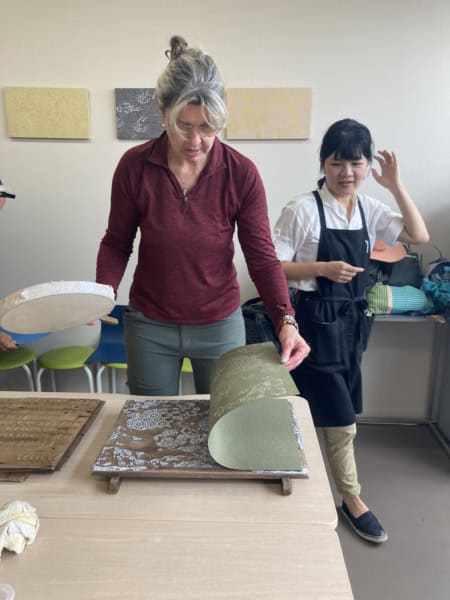 |
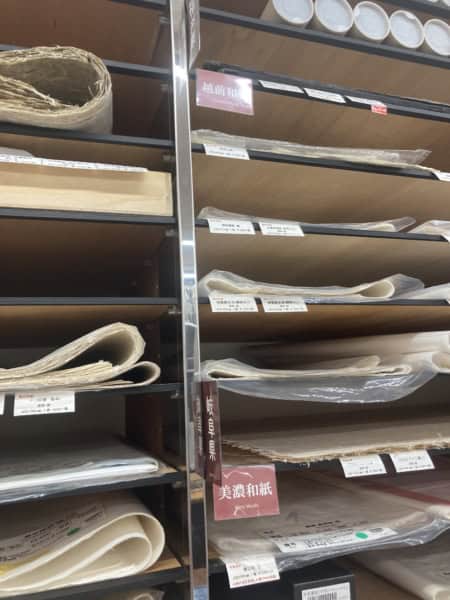 |
Studio Tour + The Grand Finale
That evening, we went to Masa and Sarah’s house for a studio tour with Sarah Brayer, who works in paper, creating work in Echizen as well as in her lovely standalone studio. The tour was followed by a dinner that Masa prepared with his assistants.
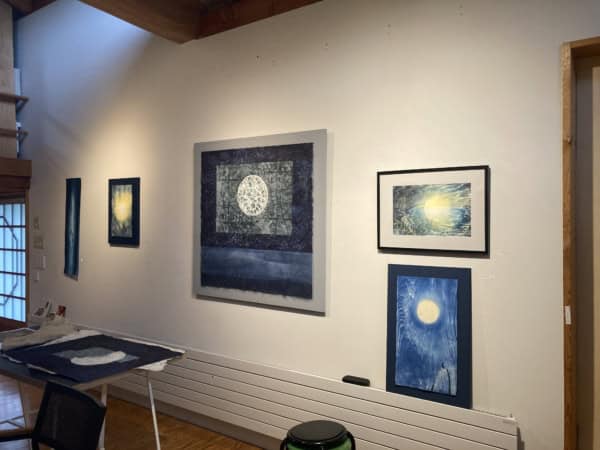 |
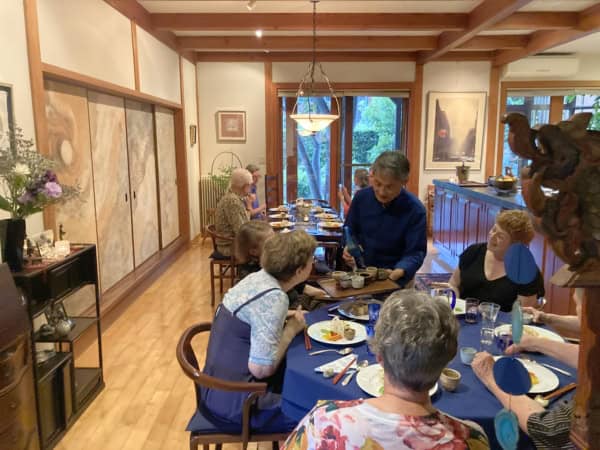 |
The grand finale was really special. We were seated at a table in front of fusuma door panels that were painted by Sarah, when Masa opened the doors to unveil a room behind them. A geiko (geisha) was sitting there in front of a wall of shoji screens. She performed three dances for us and answered our questions.
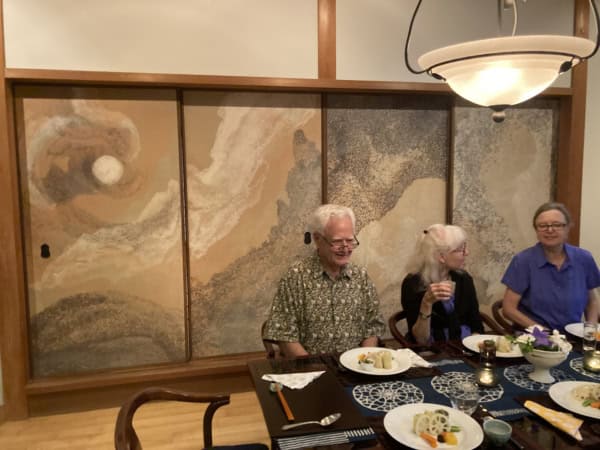 |
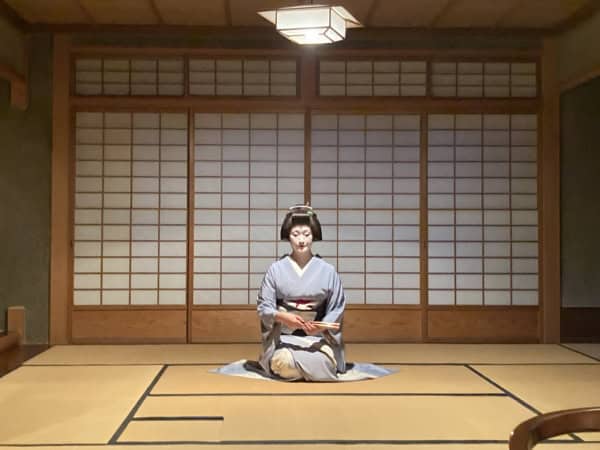 |
I’d never done anything like this (organizing, planning and leading a tour), and I really enjoyed it. I loved being in Japan, and I’m considering putting together another one in 2026. Feel free to let me know if you’re interested in coming along. In the meantime, I purchased quite a bit of paper (which I unveiled in several recent posts over on Instagram). I’m keeping some for myself, but I’m creating a sampler for those of you who would like a selection of unique papers from Japan. I’ll offer those for sale later this week, and you (my blog readers) along with my newsletter subscribers, will be the first to hear about it. Thanks for for following my paper journey!
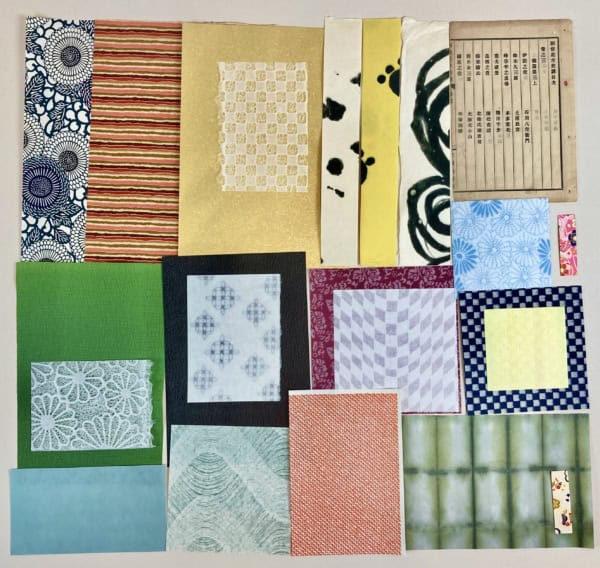

18 Comments
Thank you for sharing your experience with us. This was all so enjoyable and worth reading over a few times. Looking forward to more information about your trip. Impressive!
Thank you!
Paper overload ( in a good way!). This trip sounds amazing..
Thanks, Diane! Looking forward to August.
Thanks so much for your story and images from Japan. It reminded me of the trip I made with 5 other paper makers to China in 2002. It was guided by Elaine and Sidney Koretsky who are now gone. I recently went thru the photo albums from that trip and relived the wonderful memories.
Nancy, how cool that you got to go to China with Sidney & Elaine. I always loved their retelling of those trips at conferences.
Thanks for this great recap and the wonderful tour Helen!
So glad you could come along :).
Amazing trip, !!! if you organize a future one , I am in😀
I’ll add you to the growing list. Thanks for your interest, Leticia!
Your trip to Japan sounds amazing! I would be interested in going too!
Thanks, April. I add you to the list.
Helen, what a fabulous trip! Not only for papermakers but for art, architecture and garden lovers. Thanks for all of your hard work in making it happen, and thanks to all of our wonderful hosts. It was a great experience!
Awww Diane! Thank you so much for pointing out that you enjoyed the tour as a non papermaker. So glad you came with us!
I’m also interest in a future trip! What a fabulous tour!
Great, Eleanor! I’ll put you on the list.
I absolutely adored every aspect of this tour! Even though I’m not an advanced paper/book artist, I learned so much – not only about the paper and other sites we visited, but from the other participants. Every moment was exciting, inspiring, beautiful, and adventurous. Did I have fears prior to going? Yes! Am I too old? Will I keep up the pace? Will I fit in? None of my fears came true. I loved every minute, and I’m amazed at the superb job Helen did, and with such kindness. Are you *sure* you never did a tour before?? 🙂
Thanks for your kind words, Helen! TBH, I had many fears as well, and they didn’t come true, either We had a wonderful group! And, no, I’ve never led a tour, but I have many life experiences!